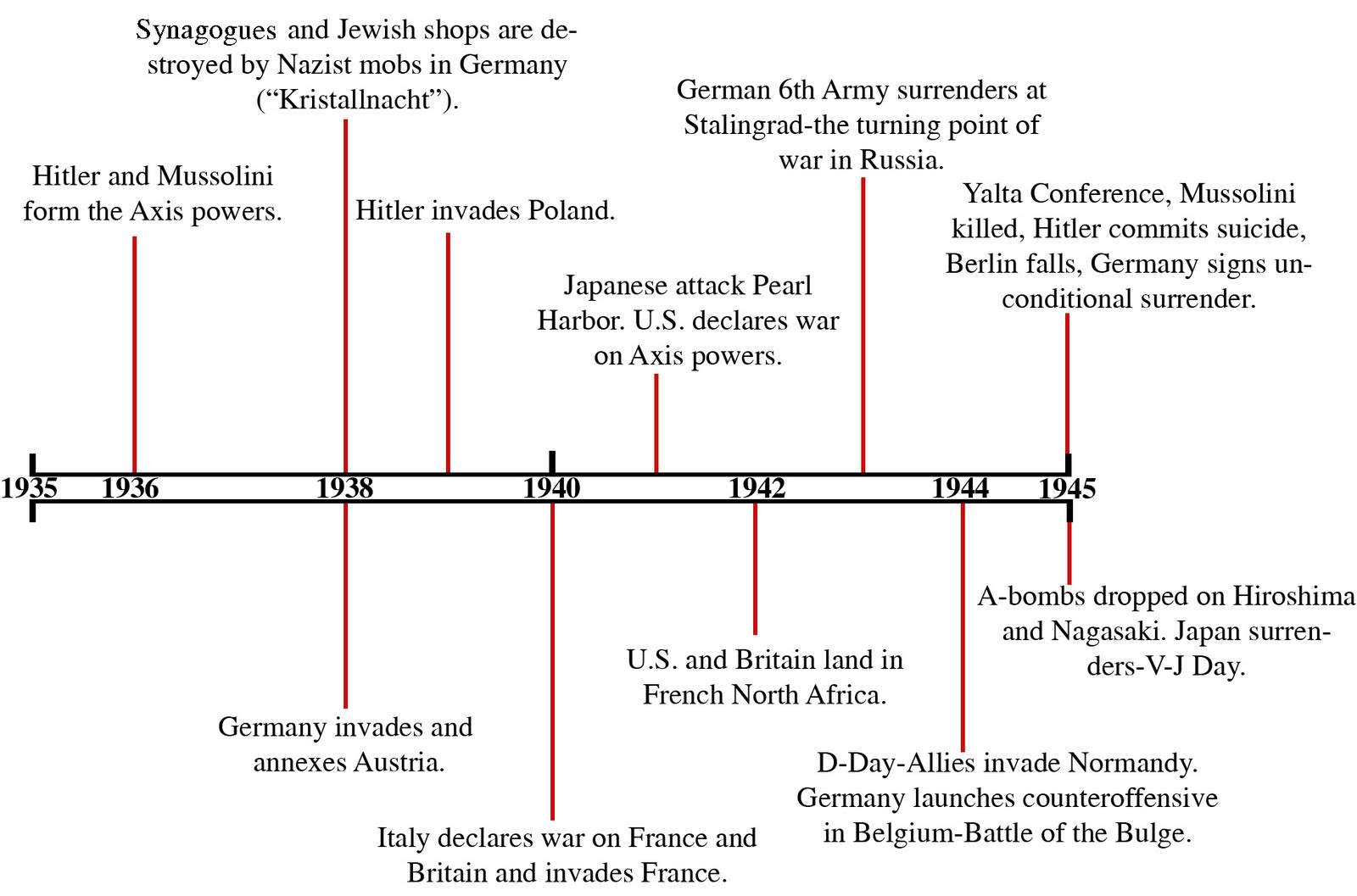The timeline of World War II (WW2) is a complex and multifaceted narrative that shaped the course of history. Understanding the key events that led to the outbreak of this global conflict, as well as its progression and eventual conclusion, is essential for grasping the implications of the war on modern society. In this article, we will explore the timeline of events during World War II, highlighting crucial battles, political decisions, and significant milestones that defined this period.
The Second World War was not just a series of battles; it was a clash of ideologies, a fight for power, and a struggle for survival among nations. From the invasion of Poland in 1939 to the dropping of atomic bombs on Hiroshima and Nagasaki in 1945, each event played a pivotal role in shaping the future of the world. This article aims to provide an in-depth analysis of these events, emphasizing their significance and consequences.
As we delve into the timeline of World War II, it is important to recognize the complexity of the war and its lasting impact on international relations, socio-economic structures, and cultural memories. Join us as we embark on this historical journey, uncovering the events that changed the world forever.
Table of Contents
- Pre-War Events (1930-1939)
- Outbreak of War (1939)
- Major Battles and Campaigns (1940-1945)
- Home Front and War Economy
- End of War and Aftermath (1945)
- Impact of WWII on the World
- Conclusion
- Sources
Pre-War Events (1930-1939)
Before the official start of World War II, a series of political and social events set the stage for the global conflict. The Treaty of Versailles, which ended World War I, left Germany in economic turmoil and political instability. This discontent fueled the rise of Adolf Hitler and the Nazi Party, who promised to restore Germany's former glory.
Key Events Leading to the War
- 1933: Adolf Hitler becomes Chancellor of Germany.
- 1935: Nuremberg Laws are enacted, stripping Jews of citizenship.
- 1936: Germany remilitarizes the Rhineland.
- 1938: Munich Agreement allows Germany to annex Sudetenland.
- 1939: Germany invades Poland, prompting Britain and France to declare war.
Outbreak of War (1939)
World War II officially began on September 1, 1939, when Germany invaded Poland. This aggressive act was the culmination of years of expansionist policies and militarization by the Nazi regime. In response, Britain and France declared war on Germany on September 3, 1939.
Key Events in 1939
- September 1: Germany invades Poland.
- September 3: Britain and France declare war on Germany.
- September 17: Soviet Union invades Poland from the east.
- October 6: Poland surrenders to German and Soviet forces.
Major Battles and Campaigns (1940-1945)
The years following the outbreak of war saw numerous significant battles and campaigns that would ultimately determine the fate of nations. Key turning points included the Battle of Britain, Operation Barbarossa, and the Normandy Invasion.
Significant Battles
- Battle of Britain (1940): The Royal Air Force defends the UK against large-scale attacks by the German Luftwaffe.
- Operation Barbarossa (1941): Germany invades the Soviet Union, marking a crucial turning point in the war.
- Battle of Stalingrad (1942-1943): A significant Soviet victory that marked the turning of the tide against the Nazis.
- Normandy Invasion (D-Day, 1944): Allied forces launch a massive invasion of German-occupied France.
Home Front and War Economy
The home front played a vital role in supporting the war effort. Governments mobilized resources, and citizens contributed through various means. The war economy saw a shift towards wartime production, significantly impacting labor and industry.
Key Features of the Home Front
- War Production: Factories converted to produce military equipment.
- Rationing: Governments imposed rationing to manage scarce resources.
- Propaganda: Campaigns encouraged public support for the war effort.
- Women in Workforce: Increased participation of women in various industries.
End of War and Aftermath (1945)
The end of World War II came with the unconditional surrender of Germany in May 1945 and Japan in September 1945. The consequences of the war were profound, leading to significant geopolitical changes and the establishment of the United Nations.
Key Events in 1945
- May 7: Germany surrenders unconditionally.
- August 6: The United States drops an atomic bomb on Hiroshima.
- August 9: The United States drops an atomic bomb on Nagasaki.
- September 2: Japan formally surrenders, marking the end of World War II.
Impact of WWII on the World
The impact of World War II was felt globally, reshaping political boundaries, economies, and societies. The creation of the United Nations aimed to prevent future conflicts, while the war also led to the Cold War between the United States and the Soviet Union.
Long-term Consequences
- Geopolitical Changes: The emergence of the United States and the Soviet Union as superpowers.
- Economic Impact: The Marshall Plan helped rebuild European economies.
- Cultural Shift: Changes in social attitudes and movements for civil rights.
- Technological Advancements: Innovations in warfare and technology.
Conclusion
The timeline of World War II is filled with pivotal moments that shaped the course of history. From the pre-war events that set the stage for conflict to the battles that determined the fate of nations, understanding these events is crucial for comprehending the complexities of modern society. We invite you to share your thoughts in the comments, explore related articles, and join the discussion on the impacts of World War II.
Sources
1. United States Holocaust Memorial Museum. (n.d.). Timeline of Events.
2. BBC History. (n.d.). World War Two.
3. Encyclopedia Britannica. (n.d.). World War II.
Edgar Guzmán López: The Life And Legacy Of A Rising Star
Whitney Cummings Boyfriend: A Deep Dive Into Her Love Life
Emily Campagno's Husband: Unveiling The Life Behind The Star


